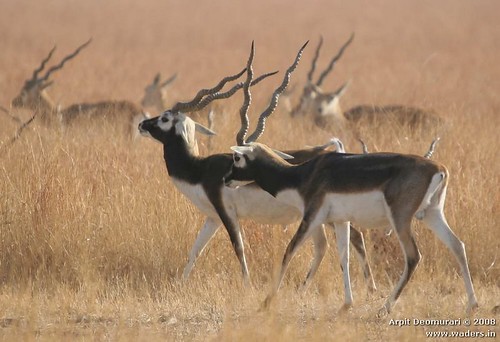Blackbuck (Antilope cervicapra), is a species of antelope native to the Indian subcontinent. Their range decreased sharply during the 20th century. Since 2003, the IUCN lists the species as near threatened. This species is the only member of the genus Antilope, and has been introduced in Texas and Argentina. It is one of the fastest of all terrestrial animals reaching speeds of up to 80 km/h and is one of the few antelopes where males and females have distinctive coloration, as the male bucks are a distinctive black and white and have long twisted horns, while females are fawn coloured with no horns. In its scientific name Antilope cervicapra, 'Antilope' from 'anthalops' (Greek) a horned animal; 'cervicapra' from 'cervus' (Latin) a deer and 'capra' (Latin) a she-goat.
The blackbuck, as the provincial animal of India it is known as Krishna Mriga in Kannada. Also known as Krishna Jinka in Telugu, it has been declared as the state animal of Andhra Pradesh. Other local names for the species include Krishnasar in Bengali, Kala Hiran, Sasin, Iralai Maan, and Kalveet in Marathi. It is often simply called Indian antelope though this term might also be used for other Antilopinae from the region. The skin of Krishna Mrigam plays an important role in Hinduism, and Brahmin boys are traditionally required to wear a strip of unleathered hide after performing Upanayam.
The distinctive horns of the Blackbuck are ringed with 1 to 4 spiral turns, rarely more than 4 turns, and can be as long as 79 cm (31 in). A trophy Blackbuck is greater than 46 cm (18 in). In the male, the upper body is black (dark brown), and the belly and eye rings are white. The light-brown female is usually hornless. Blackbuck usually roam the plains in herds of 15 to 20 animals with one dominant male.
On the open plain, the Blackbuck is one of the fastest animals and can outrun most predators over long distances. Its chief predator was the now extinct Indian Cheetah. It is now sometimes preyed upon by wolves, feral dogs, etc. The diet of the Blackbuck consists mostly of grasses, although it does eat pods, flowers and fruits to supplement its diet. The maximum life span recorded is 16 years and the average is 12 years.
Originally spread over large tracts of India (except in North East India). Today the blackbuck population is confined to areas in Maharasthra, Orissa, Punjab, Rajasthan, Haryana, Gujarat, Andhra Pradesh, Tamil Nadu and Karnataka with a few small pockets in Central India. In Nepal, the last surviving population of blackbuck is found in the Blackbuck Conservation Area south of the Bardia National Park. In 2008, the population was estimated to comprise 184 individuals. Its original habitat is open plain and not dense jungle during the early part of the 20th century for the purpose of hunting and breeding.
The main threats to the species are: Poaching, Predation, Habitat destruction, Overgrazing, Diseases, Inbreeding and Sanctuary visitors. Large herds once roamed freely on the plains of North India, where they thrived best, but no longer. During the eighteenth, nineteenth and the first half of the twentieth centuries, Blackbuck was the most hunted wild animal all over India. Although Indian law strictly prohibits the hunting of these endangered animals, there are still occasional incidents of poaching. The remaining populations are under threat from inbreeding. The natural habitat of the Blackbuck is being encroached upon by man's need for arable land and grazing ground for domesticated cattle. Exposure to domesticated cattle also renders the Blackbuck exposed to bovine diseases. It used to be one of the most abundant hoofed mammal in the Indian subcontinent, so much so that as late as early 1900s, naturalist Richard Lydekker mentions herds of hundreds in his writings, though today only small herds are seen inside reserves, chief reason of their decline being excessive hunting.
Like most wild animals, the Blackbuck is in principle protected in India by the Wildlife Protection Act of 1972. Its protected status has gained publicity through a widely reported court case in which one of India's leading film stars, Salman Khan, was sentenced to five years imprisonment for killing two black bucks and several endangered chinkaras. The arrest was prompted by intense protests from the Bishnoi ethnic group, which holds animals and trees sacred, and on whose land the hunting had taken place. In another notorious incident of criminal poaching, Mansoor Ali Khan Pataudi also killed a Blackbuck and then absconded as a fugitive. He finally surrendered only when the case was transferred from the criminal court to a Special Environment court, where he would face lighter sentencing.
Source: Wikipedia, CITES






No comments:
Post a Comment
Many thanks for your contribution. Where applicable, we will respond to you here.